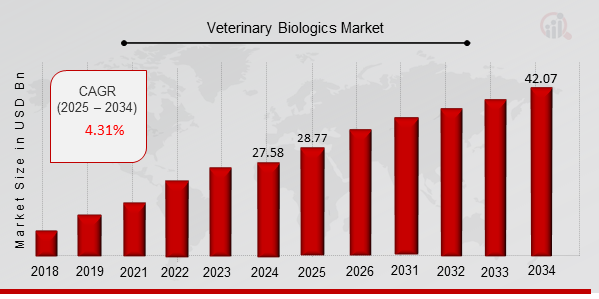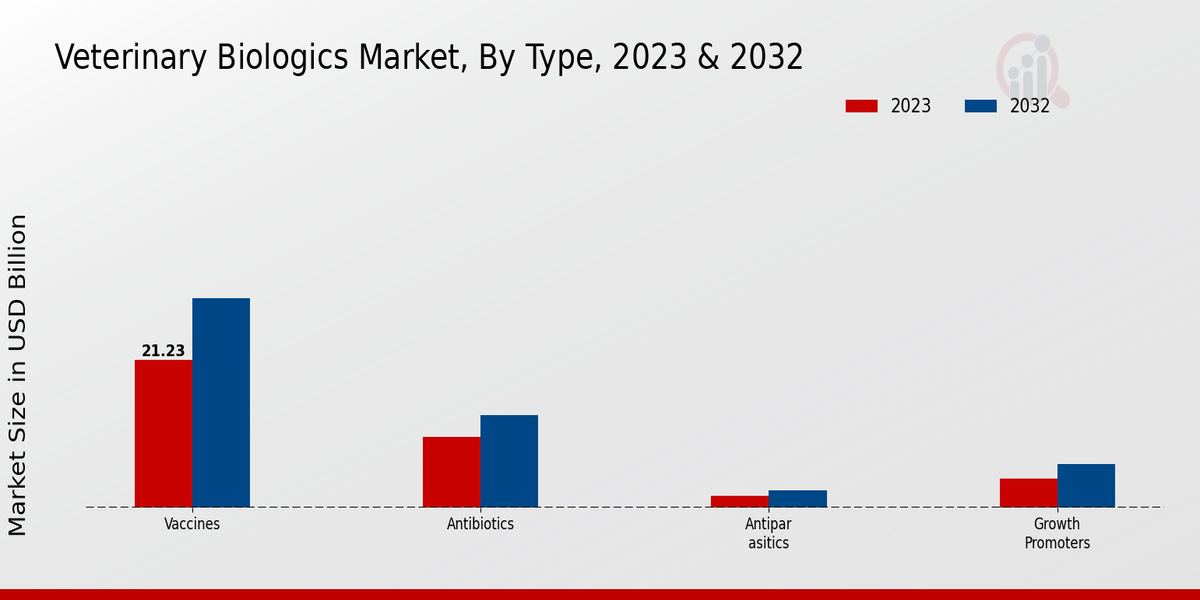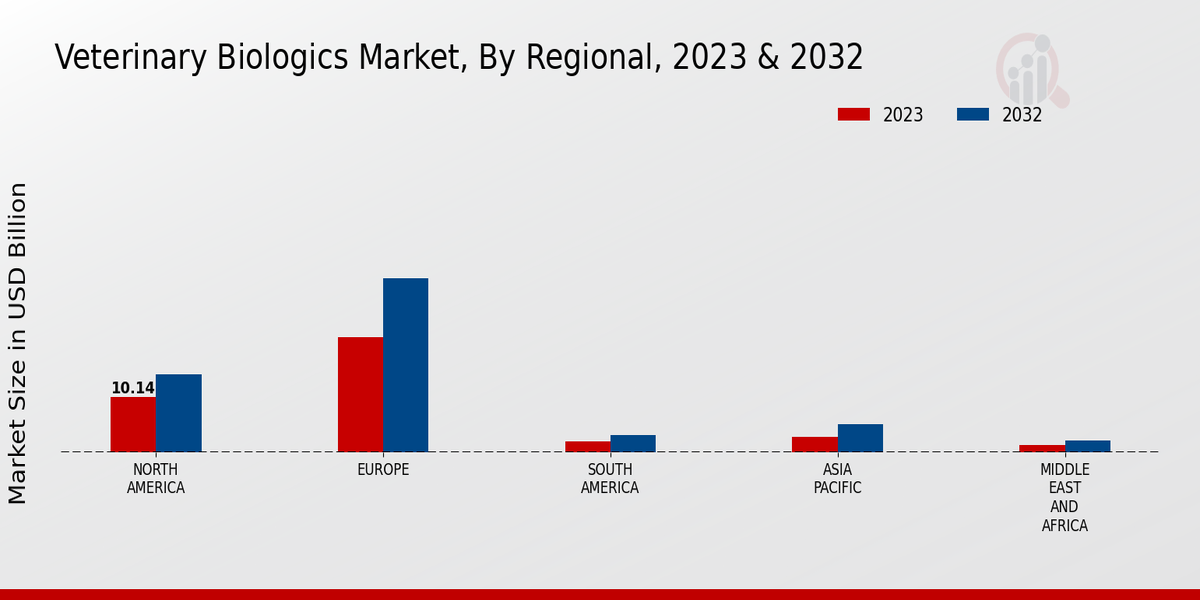Veterinary Biologics Market Overview
As per MRFR analysis, the Veterinary Biologics Market Size was estimated at 27.58 (USD Billion) in 2024. The Veterinary Biologics Market Industry is expected to grow from 28.77 (USD Billion) in 2025 to 42.07 (USD Billion) till 2034, at a CAGR (growth rate) is expected to be around 4.31% during the forecast period (2025 - 2034).
Key Veterinary Biologics Market Trends Highlighted
The market for veterinary biologics is primarily driven by rising pet ownership, rising animal health awareness, and the rise in infectious illness prevalence in animals.
Possibilities include growing into emerging markets and creating innovative treatments, diagnostics, and vaccinations.
Personalized medicine, recombinant DNA technologies, and the growth of pet insurance are examples of recent trends.
Growing awareness of animal health and welfare, increasing research and development, and technological developments are some of the reasons driving the predicted considerable rise in the market in the upcoming years.

Source: Primary Research, Secondary Research, MRFR Database and Analyst Review
Veterinary Biologics Market Drivers
Increasing Prevalence of Animal Diseases
The escalating prevalence of animal diseases is one of the most significant factors propelling the growth of the Veterinary Biologics Market. Climate change and intensive animal farming practices, as well as increased global trade in animals and animal products, have facilitated the spread of diseases.
Veterinary biologics, such as vaccines, antisera, and diagnostics, are essential for the prevention, control, and eradication of these diseases, thereby safeguarding animal health and welfare.
Consequently, the demand for veterinary biology is bound to increase with the escalating prevalence of animal diseases.
Growing Demand for Pet Healthcare
The increasing popularity of companion animals and the growing awareness of their health and well-being are driving the demand for veterinary biology. Pet owners are becoming more proactive in seeking preventive care for their pets, including vaccinations and regular check-ups.
This has led to a surge in the demand for veterinary biologics, particularly vaccines and diagnostics, as pet owners seek to protect their furry companions from diseases and ensure their longevity.
Technological Advancements
Advancements in biotechnology and genetic engineering have revolutionized the development and production of veterinary biologics.
Recombinant DNA technology, monoclonal antibodies, and gene editing techniques have enabled the creation of more effective and targeted vaccines, diagnostics, and therapeutics.
These advancements have improved the specificity, potency, and safety of veterinary biologics, enhancing their ability to prevent and treat animal diseases.
Veterinary Biologics Market Segment Insights
Veterinary Biologics Market Type Insights
The veterinary biologics market is classified into four main types. These include vaccines, antibiotics, antiparasitics, and growth promoters, which have different characteristics and uses. Vaccines are developed to prevent or cure different diseases in animals by stimulating the immune system to fight off antigens or pathogens.
Antibiotics are used to cure bacterial attacks in different body parts. Antiparasitics are used to prevent parasitic infection in animals by killing or keeping them off the animals. Growth promoters are used to increase the rate of growth and fattening of animals.
The Veterinary Biologics Market is expected to witness growth in both developed and developing countries. Vaccines were the largest segment of the market, accounting for over 50% of the total revenue in 2023.
The increasing adoption of vaccines to protect animals against different infections is one of the factors that will propel the growth of this segment. Antibiotics was the second-largest segment of the market, accounting for over 25% of the total revenue in 2023. The increasing use of antibiotics to cure different animal diseases is one of the drivers that will increase this segment.
Antiparasitics was the third-largest segment of the market, accounting for over 15% of the total revenue in 2023. The use of antiparasitics to prevent parasites that affect animals is one of the factors that will increase this segment.
Growth promoters were the smallest segment of the market, accounting for less than 10% of the total revenue in 2023. The increasing demand for animal proteins in many countries will also increase the growth of this segment. The Veterinary Biologics Market is highly competitive, with many large and small players.
Some of the key players in the market are as follows: Merck Co., Inc., Zoetis Inc., Boehringer Ingelheim, Virbac, and Ceva Animal Health. These companies are investing heavily in research and development to develop new and innovative products.

Source: Primary Research, Secondary Research, MRFR Database and Analyst Review
Veterinary Biologics Market Species Insights
The Veterinary Biologics Market is divided by species into livestock and companion animals. The livestock segment dominated the segment in terms of market share in 2023, and it is expected to continue its dominance during the forecast period.
The growth of the livestock segment can be attributed to the increasing need for animal protein, the prevalence of animal diseases, and the growing adoption of vaccination programs.
The companion animal segment is expected to grow at a steady rate in the forthcoming years. Pet ownership and the increased awareness of pet health are contributing to the growth of the companion animal segment.
The Veterinary Biologics Market for livestock will have a value of USD 18.54 billion by 2032 and will exhibit a CAGR of 4.0% during the forecast period.
The Veterinary Biologics Market for companion animals will have a value of USD 18.53 billion by 2032 and will exhibit a CAGR of 4.6% during the forecast period.
Veterinary Biologics Market Target Disease Insights
Bacterial infections were the leading target disease for veterinary biologics, accounting for a global market revenue of USD 10.23 billion in 2023.
The high prevalence of bacterial diseases in livestock, such as bovine respiratory disease complex and porcine reproductive and respiratory syndrome, drives the demand for vaccines and other biologics to prevent and treat these infections.
Viral infections are another significant target disease, with a market size of USD 8.76 billion in 2023. The rising incidence of parasitic diseases in animals, coupled with the increasing adoption of companion animals, is fueling the growth of this market.
Metabolic disorders are also a key target disease for veterinary biologics, with the market worth USD 4.87 billion in 2023. The increasing prevalence of obesity and other metabolic disorders in pets is driving the demand for biologics to manage and treat these conditions.
Veterinary Biologics Market Source Insights
The Veterinary Biologics Market is segmented based on source, which includes cell culture, inactivated pathogens, and recombinant technologies.
Cell culture held the largest share of the market in 2023 and is expected to continue to dominate during the forecast period, owing to the increasing use of cell-based vaccines and therapeutics. The inactivated pathogens segment is also expected to witness significant growth, as these vaccines are cost-effective and have a proven track record of safety and efficacy.
Recombinant technologies offer advantages such as high specificity, purity, and consistency and are expected to gain traction in the coming years.
The market growth is attributed to the increasing prevalence of animal diseases, rising demand for preventive healthcare measures, and technological advancements.
Veterinary Biologics Market Application Insights
The Veterinary Biologics Market is segmented by Application into Disease Prevention, Disease Treatment, and Growth Promotion.
Among these, the Disease Prevention segment accounted for the largest revenue share in 2023 and is projected to maintain its dominance throughout the forecast period. This is primarily attributed to the increasing adoption of preventive measures by animal owners to safeguard their livestock from diseases.
The Disease Treatment segment is expected to witness significant growth over the forecast period, owing to the rising prevalence of animal diseases and the increasing demand for effective treatment options.
The Growth Promotion segment is also anticipated to experience steady growth, driven by the demand for biologics that enhance animal growth and productivity.
Veterinary Biologics Market Regional Insights
The regional landscape of the Veterinary Biologics Market exhibits significant growth opportunities across various regions.
North America held a dominant position in the market in 2023, capturing around 40% of the global revenue share. The region's well-established veterinary infrastructure, high pet ownership rates, and advanced animal healthcare practices contribute to its market dominance.
Europe follows closely, accounting for approximately 30% of the market share. The region's stringent regulatory framework, focus on animal welfare and presence of major pharmaceutical companies drive its market growth.
The Asia-Pacific (APAC) region is poised for substantial growth in the coming years, with a projected CAGR of 6.2% during the forecast period (2024-2032). Growing pet ownership, rising disposable income, and increasing awareness about animal health in countries like China, India, and Japan are key factors fueling the market expansion in APAC.
South America and the Middle East and Africa (MEA) regions are also expected to witness steady growth, driven by government initiatives to improve animal health and increasing investments in veterinary infrastructure.

Source: Primary Research, Secondary Research, MRFR Database and Analyst Review
Veterinary Biologics Market Key Players and Competitive Insights
Major competitors in the veterinary biologics market are continuously trying to expand their market share and improve their competitive position. These companies are focused on research and development of innovative products to cater to the changing needs of the market.
Moreover, leading competitors in the veterinary biologics market are entering into acquisitions and mergers to enrich their product portfolios. In the coming years, veterinary biologics market is expected to grow at a rapid pace on account of presence of several driving factors such as increasing population of animals, growing demand for animal protein, and ever-widening awareness about animal health.
The veterinary biologics market Competitive Landscape is an intense market as major competitors are trying to enhance their market share.
Zoetis is one of the key players in Veterinary Biologics Market. The company had a strong R focus and a diverse set of products. Formerly a part of Pfizer, Zoetis has a vast network of distributors and customers all around the world.
The company’s core strength lies in developing and selling parasiticides, vaccines, and other animal health products. In addition, Zoetis is a pioneer in using new technologies as the company is actively involved in developing recombinant vaccines, monoclonal antibodies, and DNA vaccines.
Lastly, Zoetis is a highly acquisitive company and is actively using acquisitions and partnerships to complement its product lines.
Another prominent Veterinary Biologics Market competitor is Merck Animal Health. It is also a research and production-focused company with a number of innovative products such as recombinant vaccines, monoclonal antibodies, and DNA vaccines.
The company has a vast network of distributors and customers around the world. Moreover, Merck Animal Health is actively acquisitive, which means it is always in the search for companies or products that will complement its existing products or fill a major gap in the portfolio.
Key Companies in the veterinary biologics market Include
- Hipra
- Zoetis
- Boehringer Ingelheim
- Tsinghua Tongda
- Bayer Animal Health
- Intervet
- Elanco Animal Health
- Ceva Animal Health
- Vétoquinol
- Beijing SVA Vaccines Serums
- Virbac
- Harbin Veterinary Research Institute
- Shenzhen Kangtai Biological Products
- Chongqing Zhifei Biological Products
- Merck Animal Health
Veterinary Biologics Market Developments
The Veterinary Biologics Market is poised to grow significantly in the coming years, driven by rising pet ownership, increasing awareness of animal health, and technological advancements in vaccine development.
Recent developments in the market include the launch of new vaccines for animal diseases such as African swine fever and avian influenza, as well as the increasing adoption of personalized medicine approaches to animal healthcare.
Key players in the market are investing in research and development to expand their product portfolios and enhance the efficacy of their biologics.
Strategic collaborations and acquisitions are also shaping the competitive landscape as companies seek to strengthen their market positions and gain access to new technologies.
Veterinary Biologics Market Segmentation Insights
Veterinary Biologics Market Type Outlook
- Vaccines
- Antibiotics
- Antiparasitics
- Growth Promoters
Veterinary Biologics Market Species Outlook
- Livestock
- Companion Animals
Veterinary Biologics Market Target Disease Outlook
- Bacterial Infections
- Viral Infections
- Parasitic Infections
- Metabolic Disorders
Veterinary Biologics Market Source Outlook
- Cell Culture
- Inactivated Pathogens
- Recombinant Technologies
Veterinary Biologics Market Application Outlook
- Disease Prevention
- Disease Treatment
- Growth Promotion
Veterinary Biologics Market Regional Outlook
- North America
- Europe
- South America
- Asia Pacific
- Middle East and Africa
| Report Attribute/Metric |
Details |
|
Market Size 2024
|
27.58 (USD Billion)
|
|
Market Size 2025
|
28.77 (USD Billion)
|
|
Market Size 2034
|
42.07 (USD Billion)
|
|
Compound Annual Growth Rate (CAGR)
|
4.31 % (2025 - 2034)
|
|
Report Coverage
|
Revenue Forecast, Competitive Landscape, Growth Factors, and Trends
|
|
Base Year
|
2024
|
|
Market Forecast Period
|
2025 - 2034
|
|
Historical Data
|
2020 - 2024
|
| Market Forecast Units |
USD Billion |
| Key Companies Profiled |
Hipra, Zoetis, Boehringer Ingelheim, Tsinghua Tongda, Bayer Animal Health, Intervet, Elanco Animal Health, Ceva Animal Health, Vétoquinol, Beijing SVA Vaccines Serums, Virbac, Harbin Veterinary Research Institute, Shenzhen Kangtai Biological Products, Chongqing Zhifei Biological Products, Merck Animal Health |
| Segments Covered |
Type, Species, Target Disease, Source, Application, Regional |
| Key Market Opportunities |
Rising pet ownership, increasing prevalence of animal diseases, technological advancements, growing government initiatives, and emerging markets. |
| Key Market Dynamics |
Increasing pet ownership, animal disease outbreaks, and technological advancements. |
| Countries Covered |
North America, Europe, APAC, South America, MEA |
Frequently Asked Questions (FAQ) :
The Veterinary Biologics Market is expected to reach USD 42.07 billion by 2034, exhibiting a CAGR of 4.31% during the forecast period (2025-2034).
The rising prevalence of animal diseases, increasing pet ownership, and growing awareness about animal health are the primary factors fueling the growth of the veterinary biologics market.
North America is anticipated to account for the largest market share in the veterinary biologics market due to the presence of well-established animal healthcare infrastructure and high pet ownership rates.
Veterinary biologics are primarily used for the prevention and treatment of animal diseases, including vaccines, antisera, and diagnostics.
Zoetis, Merck Animal Health, Boehringer Ingelheim, and Ceva Animal Health are among the leading players in the veterinary biologics market.
Regulatory hurdles, stringent quality control requirements, and the high cost of research and development are some of the challenges faced by the veterinary biologics market.
The increasing adoption of personalized medicine, advancements in biotechnology, and the growing use of biologics in companion animals are emerging trends in the veterinary biologics market.
The veterinary biologics market is projected to grow at a CAGR of 4.31% from 2025 to 2034.
2023 is the base year considered for the veterinary biologics market forecast.
2034 the end year considered for the veterinary biologics market forecast.

















